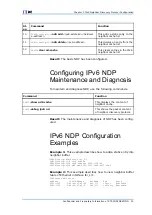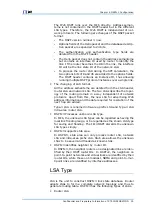
Chapter 3 IPv6 Neighbor Discovery Protocol Configuration
must send the advertisement immediately rather than wait for
the next scheduled transmission time.
�
Neighbor Advertisement
A node must send the neighbor advertisement packet upon re-
ceiving the request of the neighbor solicitation packet or upon
any change of its link-layer address.
�
Neighbor Solicitation
A node sends the neighbor solicitation packet to request the
neighbor's link-layer address to authenticate the accessibility
of the neighbor's link-layer address obtained and saved in the
cache, or authenticate that its address is unique on the local
link.
�
Redirection
A router sends a redirection packet to notify a host that it is
not the optimum router for a specific destination.
The router sends the router advertisement packet through multi-
cast, so that the nodes on the same link can construct their own
available default router list.
Neighbor discovery can also be used to realize other targets, in-
cluding:
�
Link-layer Address Change
A node may have multiple interfaces for the same network. If
the node knows that its link-layer address is changed, it can
send some multicast groups to notify other nodes of its address
change.
�
Entry Load Balancing
A node receiving a large number of service flows may have
multiple network interfaces, which can be represented by an
IP address if neighbor discovery is employed. The router load
balancing can be realized by making the router omit the source
link-layer address during its sending of the router advertise-
ment packet.
Every time when a node that searches this router wants to send
packets to this router, it must execute the neighbor discovery.
Then, the router can select the link-layer interface that receives
the packets to respond to this node.
�
Anycast Address
As mentioned above, an anycast address is a set of the unicast
addresses. The packet sent to an anycast address will be de-
livered to anyone of its unicast addresses. An anycast address
is used to identify a set of nodes providing the same service,
that is, send a packet to any node of an anycast address with-
out caring which one among the node-set will respond.
Due to multiple members of an anycast address may respond
to the request for their respective link-layer address, the neigh-
bor discovery mechanism requires that a node must be able to
predict the possible multiple responses to be received and han-
dle them properly.
�
Proxy Advertisement
Confidential and Proprietary Information of ZTE CORPORATION
21
Содержание ZXR10 T1200
Страница 5: ...Figures 71 Tables 73 List of Glossary 75 ...
Страница 6: ......
















































